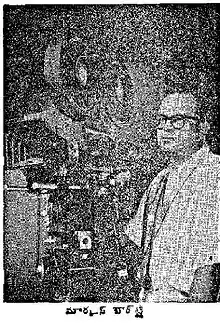Marcus Bartley
Marcus Bartley (22 April 1917 – 14 March 1993)[1] was an Anglo-Indian cinematographer known for his works predominantly in Telugu cinema along with a few Hindi, Malayalam, and Tamil films. He was the cinematographer of all time classics like Shavukaru (1950), Pathala Bhairavi (1951), Missamma (1955), Maya Bazaar (1957), Gundamma Katha (1962), Chemmeen (1965), Ram Aur Shyam (1967). He won the National Film Award for Best Cinematography in 1970 for Shanti Nilayam. He also won the Gold Medal at the Cannes Film Festival for Best Cinematography, becoming the first Indian to win the award.[2]
Marcus Bartley | |
|---|---|
 | |
| Born | 22 April 1917 |
| Died | 14 March 1993 (aged 75–76) |
| Occupation | Cinematographer |
Early life
Marcus Bartley was born into an Anglo-Indian family of renowned doctors in Yercaud.[2] While at school, Bartley was an amateur photographer.
Career
In 1940, Bartley headed to Bombay and joined The Times of India as press photographer, and then became a newsreel cameraman for British Movietone under the auspices of The Times of India. Bartley did not have any formal training in photography. He worked hard and learned the craft on the job.[2]
Bartley arrived in Madras and joined Pragati Studios. His maiden film was Swarga Seema in 1945. This film showed his genius at Black and White photography. The movie strengthened the friendship between him and the B. N. Reddy, K. V. Reddy, and Nagi Reddi. Successively, Bartley worked in many studios such as National Studios, Newtone Studios and Vauhini Productions.
He wielded camera for all the forty odd Vauhini movies including such great hits as Yogi Vemana (1947), Gunasundari Katha (1949), as well as Vijaya's productions Shavukaru (1950), Pathala Bhairavi (1951), Pelli Chesi Chudu (1952), Chandraharam (1954), Missamma (1955), Maya Bazaar (1957), Appu Chesi Pappu Koodu (1958), Gundamma Katha (1962), Sri Rajeswari Vilas Coffee Club (1976) etc. Most of the superhits of those times were made with his photographic hand at the camera. His specialty was the shots under the moonlight.[3]
Ramu Kariat signed him for the Malayalam film Chemmeen (1965). The film was released in 1965, to universal critical acclaim. The photography by Bartley was highly praised. Bartley didn't receive the National Award that year as portions of the film had to be completed by another cameraman. Cameraman U Rajagopal who also shot the film later acknowledged that he was only called in to complete patchwork.[2]
Working style
Bartley was known as a perfectionist. He didn’t believe in hierarchies and treated everyone the same.[2] He would work with the screenwriter and director, understanding the screenplay, so he could work on his lighting style. He would work for nights before the commencement of shooting, lighting the set to make it perfect.[2]
Personal life
He spoke fractured Telugu and Tamil and did not understand Hindi.[2] Bartley had long suffered with diabetes, but refused to go to a doctor and treated himself. In the final years of his life, Arriflex made him their authorised service person and Bartley would spend much time repairing lenses. He was shifted to Vijaya Hospital by Nagi Reddi where he was given personal attention.[2]
Awards
- Recipient of the gold medal at the International Film Festival held at Cannes for the movie Chemmeen in Malayalam in the year 1978.[4]
- He won the National Film Award for Best Cinematography in India in 1970 for Shanti Nilayam.
- He also won the Tamil Nadu State Film Award for Best Cinematographer for Shanti Nilayam in 1970.
Filmography
- Zindagi Jeene Ke Liye (1984)
- Maamaankam (1979)
- Yehi Hai Zindagi (1977)
- Sri Rajeswari Vilas Coffee Club (1976)
- Chakravakam (1974)
- Ghar Ghar Ki Kahani (1970)
- Shanti Nilayam (1969)
- Saathi (1968)
- Ram Aur Shyam (1967)
- Chemmeen (1965)
- Gundamma Katha (1962)
- Jagadeka Veeruni Katha (1961)
- Appu Chesi Pappu Koodu (1958)
- Mayabazar (1957)
- Missamma (1955)
- Chandraharam (1954)
- Kalyanam Panni Paar (1952)
- Pelli Chesi Choodu (1952)
- Patala Bhairavi (1951)
- Shavukaru (1950)
- Gunasundari Katha (1949)
- Yogi Vemana (1947)
- Swargaseema (1945)
References
- "Sri Marcus Bartley's Biography". Marcusbartley.info. Archived from the original on 19 February 2011. Retrieved 15 October 2022.
- Shah, Rochelle (5 April 2017). "Marcus Bartley: A life in pictures". The Hindu. ISSN 0971-751X. Retrieved 15 October 2022.
- Ace lensman recalls magic moments in the Hindu
- "Fifty and still refreshing in the Hindu". Archived from the original on 9 August 2010. Retrieved 9 September 2009.
{{cite web}}: CS1 maint: unfit URL (link)